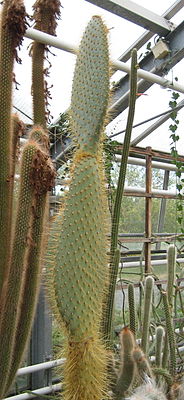Opuntia megasperma
| Opuntia megasperma | ||||||||||||
|---|---|---|---|---|---|---|---|---|---|---|---|---|

Opuntia megasperma in culture |
||||||||||||
| Systematics | ||||||||||||
|
||||||||||||
| Scientific name | ||||||||||||
| Opuntia megasperma | ||||||||||||
| JTHowell |
Opuntia megasperma is a species of plant in the genus Opuntia ( Opuntia ) from the cactus family(Cactaceae). The epithet of the species is derived from the Greek words μέγα (mega) for "large" and σπέρμα (sperma) for "seed" and refers to the very large seeds of the species.
description
Opuntia megasperma grows like a tree with rounded crowns and freely sprawling branches and reaches a height of 2 to 6 meters. The trunk, which is initially thorny and later covered with platelets, is usually clearly defined and can reach a diameter of up to one meter. The greenish yellow to blue-green shoot sections are round, egg-shaped to oblong, 25 to 37 centimeters long, 15 to 25 centimeters wide and 1.8 to 3.4 centimeters thick. The areoles , which are 30 to 42 millimeters apart , are egg-shaped and have a diameter of 2 to 6 millimeters. They have few or no glochids . The 8 to 50 thorns are yellow and turn reddish brown or dark brown with age.
The yellow to reddish yellow flowers are 6 to 13 centimeters long and 6 to 11 (or more) centimeters in diameter. The green, later yellowish green fruits are top-shaped, 6 to 17 centimeters long, reach a diameter of 2.7 to 6 centimeters and are covered with small bristly thorns. The very large seeds are 5 to 13 millimeters long.
Distribution and systematics
Opuntia megasperma is common in the Galápagos Islands .
It was first described in 1933 by John Thomas Howell . A distinction is made between the following varieties :
- Opuntia megasperma var. Megasperma
- Opuntia megasperma var. Mesophytica Lundh
- Opuntia megasperma var. Orientalis (JTHowell) DMPorter
proof
literature
- Edward F. Anderson : The Cactus Family . Timber Press: Portland (Oregon), 2001, p. 507. ISBN 0-88192-498-9
- Curt Backeberg : Die Cactaceae: Handbuch der Kakteenkunde . 2nd edition, 1984, Volume I, p. 561. ISBN 3-437-30380-5
Individual evidence
- ^ Proceedings of the California Academy of Sciences . Series 4, Volume 21, p. 46. 1933